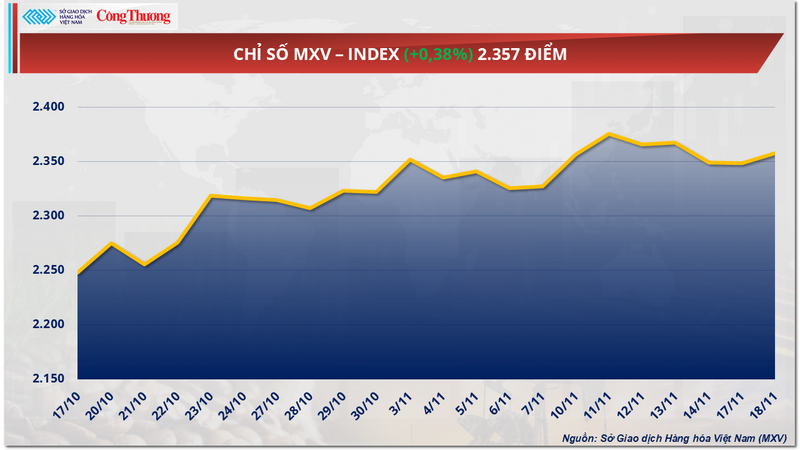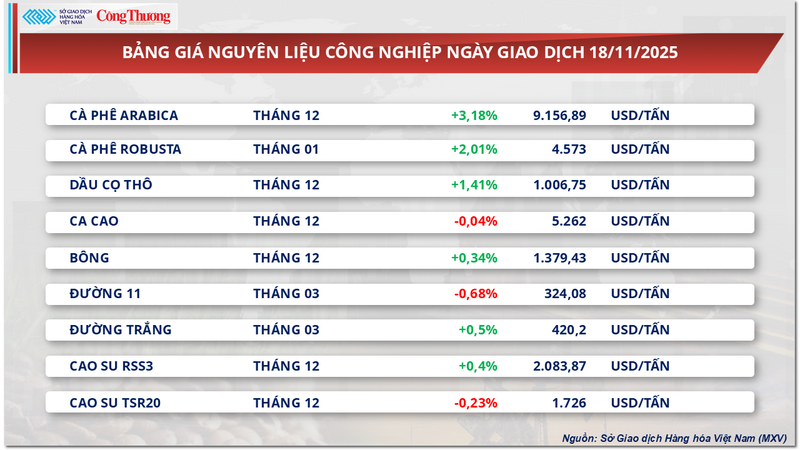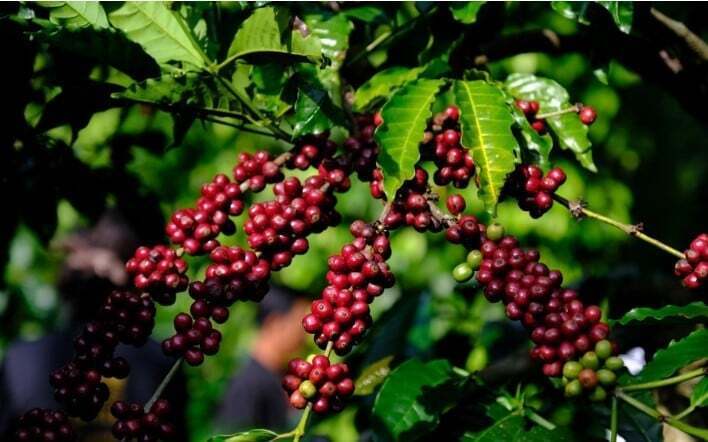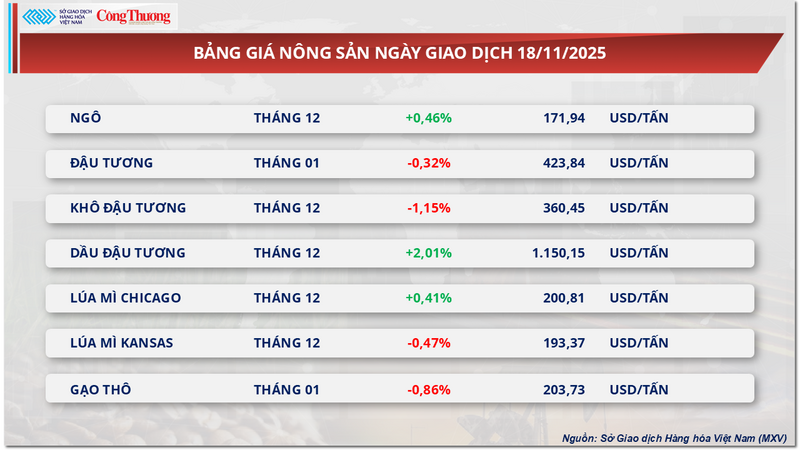Positive sentiment returned to the world raw material market in the session of November 18, when buying power recovered strongly after two cooling sessions. Corn prices continued to rise for the second consecutive session, "fueled" by the context of slow harvest progress in the US and unfavorable weather in Argentina. In the group of industrial materials, prolonged floods in the Central Highlands caused coffee prices to skyrocket. At the end of the session, the MXV-Index reached 2,357 points, up nearly 0.4%.

MXV-Index
Adverse weather pushes coffee prices up sharply
Meanwhile, in line with the general market trend, the industrial raw materials group yesterday also witnessed green covering most of the key commodities. Especially the two coffee commodities when the weather continued to be a factor causing coffee prices to increase. Specifically, the price of Arabica coffee increased by nearly 3.2% to 9,156 USD/ton while the price of Robusta coffee also increased by more than 2% to 4,573 USD/ton.

Industrial raw material price list
The Central Highlands - the Robusta coffee growing capital of Vietnam - is still facing prolonged heavy rains right after Typhoon Kalmaegi swept through, in the midst of the peak harvest period.
According to the Gia Lai Province Hydrometeorological Station, from the night of November 19 to the night of November 20, the eastern part of the province experienced moderate to heavy rain, some places had very heavy rain and thunderstorms, with rainfall ranging from 50-100 mm, some places up to over 150 mm. In Dak Lak , the night of November 16 recorded prolonged heavy rain, rainfall from the night of November 16 to the morning of November 17 ranged from 30-100 mm, some places exceeded 300 mm, causing localized flooding in many coffee growing areas. The adverse weather caused significant yield losses, and also delayed the harvesting, drying and processing processes, seriously delaying the progress of the new crop production.

Adverse weather conditions have caused significant damage to coffee yields and delayed harvesting, drying and processing, seriously delaying the production of the new crop. Illustrative photo
Further declines in inventories on ICE also supported prices. ICE-monitored Arabica inventories fell to a 1.75-year low of 396,513 bags as of yesterday, while Robusta inventories also fell to a four-month low of 5,648 lots on Monday.
Returning to the domestic market, trading activities are taking place slowly due to temporary supply constraints. Large coffee export warehouses announced purchase prices on November 18 in the range of 112,500-113,500 VND/kg, depending on quality, but are having difficulty in collecting enough goods. Many agents and farmers still tend to hold on to their goods, waiting for prices to increase further before closing the sale.
Corn prices continue to rise
At the end of yesterday's trading session, strong buying power continued to be maintained in the agricultural market. In particular, corn continued to attract attention when the price increased by nearly 0.5% to 171.9 USD/ton, extending the increase to the second session.

Agricultural product price list
In addition to the optimism that pervaded the agricultural market, corn prices were also supported by a somewhat narrowing supply. According to the latest crop progress report from the US Department of Agriculture (USDA) as of November 16, only 91% of the corn acreage in the US had been harvested, significantly lower than the 98% at the same time last year and the 5-year average of 94%. This delay has partly raised concerns about the ability to supply corn in the short term.
The supply situation from Argentina is not any better as in Buenos Aires province - the agricultural heartland of this South American country, prolonged rains and floods have seriously affected planting activities. According to information from the Rosario Grain Exchange, the total rainfall since the beginning of the year has reached 1,800 mm, double the annual average of 800 mm. As a result, about 70% of agricultural land is flooded or has excess moisture, making corn planting difficult.
In addition to supply factors, corn prices in the US are also being boosted by expectations of strong input demand from the ethanol industry. The US Energy Information Administration (EIA) has just recorded a record daily ethanol production of 1.12 million barrels/day last month. Although production has decreased somewhat, analysts still predict that ethanol production will consume more corn than in previous years, contributing to supporting prices of this commodity.
Corn export demand also recorded positive signals when the export volume in the week ending November 13 exceeded 2 million tons, a sharp increase of nearly 40% compared to the previous week, according to the latest export review report of USDA.
However, on the contrary, corn imports in China since the beginning of the year and in Europe in the 2025-2026 crop year have both recorded a sharp decrease. Corn prices are still under pressure from the November World Agricultural Supply and Demand Estimates (WASDE) Report, when USDA forecasts global corn yield and production to be higher than market expectations and corn inventories in the US continue to increase.
Prices of some other goods

Energy price list

Metal price list
Source: https://congthuong.vn/nguon-cung-that-chat-gia-ca-phe-the-gioi-tiep-tuc-leo-thang-431055.html



![[Photo] The Standing Committee of the Organizing Subcommittee serving the 14th National Party Congress meets on information and propaganda work for the Congress.](https://vphoto.vietnam.vn/thumb/1200x675/vietnam/resource/IMAGE/2025/11/19/1763531906775_tieu-ban-phuc-vu-dh-19-11-9302-614-jpg.webp)

![[Photo] General Secretary To Lam receives Slovakian Deputy Prime Minister and Minister of Defense Robert Kalinak](https://vphoto.vietnam.vn/thumb/1200x675/vietnam/resource/IMAGE/2025/11/18/1763467091441_a1-bnd-8261-6981-jpg.webp)

![[Photo] Prime Minister Pham Minh Chinh and his wife meet the Vietnamese community in Algeria](https://vphoto.vietnam.vn/thumb/1200x675/vietnam/resource/IMAGE/2025/11/19/1763510299099_1763510015166-jpg.webp)








































































































Comment (0)